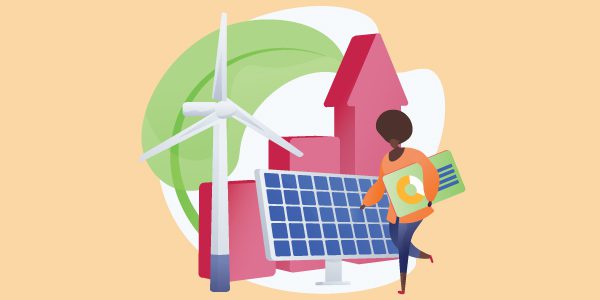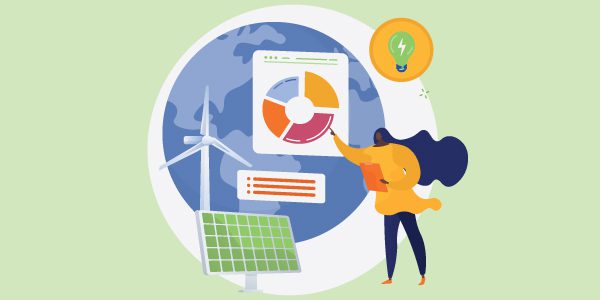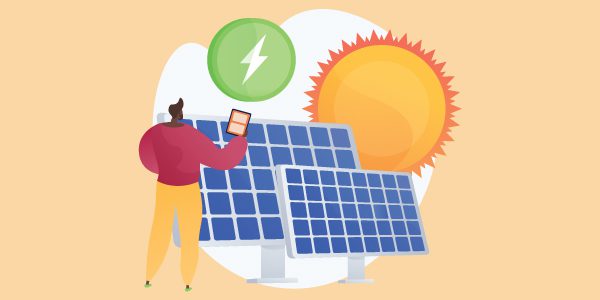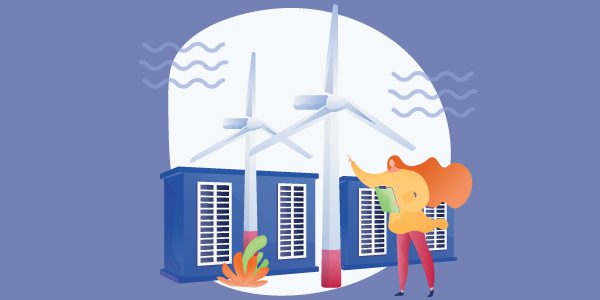Sustainable energy refers to any energy source that does not deplete.
Renewable energy, on the other hand, does deplete. However, in the quick turnaround it takes for the earth to produce the source again, it is self-sustaining. While the two terms are sometimes used interchangeably even by experts, it’s important to recognise that there is an albeit minute difference between them.
When talking of sustainable energy sources, we are referring to solar, wind, and hydro energy. In regards to renewable energy sources, again we can refer to solar, wind, and hydro, as well as, biomass, and geothermal energy. While all these sources are doing better for our planet than fossil fuel sources (such as coal, natural gas, and petroleum), renewable energy sources do have their own environmental issues.
Solar Power
Solar, deriving from the Latin word ‘solarium’ refers to energy from the sun. Solar energy is captured through panels, which can be either made up of photovoltaic (PV) cells or concentrating solar-thermal power (CSP) systems. The former, being cheaper and easier to install, is the more prevalent type.
PV solar panels convert sunlight directly into electricity; whereas CSP systems use a configuration of mirrors to concentrate the sun’s energy in order to convert it into heat, which is then generated into electricity.
Solar Environmental Impact
The predominant issue facing solar with regards to the environment is land-use; therefore the problem is mostly related to utility-scale projects. Unlike commercial projects which use the rooftops of buildings, utility-scale projects use hectares of land, which has become a point of contention between environmentalists and renewable energy advocates.
Although the two have the same end-goal for a more sustainable future, they remain divided on the land that is used. Environmentalists are concerned with the land degradation and biodiversity effects caused by the installation of solar panels. However, there have been suggestions for utility-scale solar projects to be built on land that is not viable.
Hydroelectricity / Hydropower
One of the oldest forms of renewable energy, hydropower is created through the movement of water. Hydropower is the most popular form of renewable energy globally and accounts for nearly 60% of the world’s renewable energy generation.
Hydropower, unlike renewable energy sources such as solar, wind, tidal and wave power, is not an intermittent source. Its reliability, low operating costs, low greenhouse emissions and high ramp rate make it an essential renewable energy source for any country.
There are four main types of hydropower plants:
- pumped storage
- storage
- offshore, and
- run-of-river (or also known as diversion) hydropower.
Of the four, storage (or sometimes referred to as impounded) hydropower is the most popular. Storage hydropower facilities include a dam and a reservoir to hold and keep the water, which is stored and later released when needed.
Hydropower Environmental Impact
Dams that are used for hydropower plants can have an adverse effect on functioning river systems, which in turn disrupts fish migration, water temperature, and the water’s chemistry.
The introduction of fish ladders, which allow fish a safe passage to migrate has been welcome. However, they have not yet been very effective, with a study finding only 3% of key fish species making it upriver in U.S. riverways using the ladders.
The issue of carbon emissions is also present, with hydroelectricity plants in Brazil’s Amazon reporting trees and other organic matter piling up at the bottom of the reservoirs, before decomposing and producing methane.
However, when comparing these impacts to fossil fuels, the effects pale in comparison, especially when weighed up against the typical longevity of a hydropower plant, which is 50 to 100 years.
Wind Energy
Wind energy is an energy that uses turbines that employ kinetic energy (energy that is created through motion) to produce electricity. Wind energy is one of the more popular forms of green energy and produces zero emissions when in operation.
Wind energy is found in two different types of farms: onshore and offshore. Onshore has traditionally been the more popular of the two. However, these past years have shown growth for offshore sites, particularly in Europe. In 2020, 26.3 billion Euros were invested in new offshore wind projects.
Wind Energy Environmental Impact
The two big problems with wind energy are noise pollution and use of land. Both of these issues are predominantly held against onshore wind farms. In a landmark ruling in Australia, the Victoria Supreme Court ruled against a wind farm, ordering them to turn off the wind turbines at night due to noise pollution. With rulings like this, it can negatively impact adoption of wind farms.
Land use is another issue. Although the turbine bases themselves don’t take up too much land, due to the sheer size of the turbine blades, ample space is required. A way to mitigate the sheer amount of land that is used and disturbed, is to have the land adopt a dual-function, whether it be through using it as a hiking trail, to using it as pasture lands or cropland for farming. Also, with the growing proliferation of offshore wind farms, a viable alternative is available.
Geothermal Energy
Geothermal energy is power that is derived from the heat below the earth’s crust. This heat, which is trapped kilometres below the surface, can be stored in rocks or trapped in liquids.
It is an expensive form of renewable energy, with higher up-front costs, and is consequently less popular. It costs an estimated $2 – 7million USD for plants with a 1 megawatt capacity. Additionally, given that it’s not an easily accessible resource, it is location-restricted.
However, geothermal energy, unlike solar and wind, is a more reliable source, in that it’s an energy that you ‘tap’ into rather than one in which you rely on external forces, such as the sun for solar energy. It is also relatively cheap to run.
Geothermal Energy Environmental Impact
The environmental impact of geothermal energy includes land subsidence and the possible increase in earthquakes.
Due to the nature of geothermal energy, it requires a large amount of water and steam to be taken from beneath the top-level ground. This eventually results in land subsidence, which is the surface sinking due to the absence of water.
There have been incidents in the past with these effects; however, it has been remedied through refilling the water. Due to the geothermal water being considered ‘dirty’, the replacement water does not need to be clean. Therefore, wastewater is predominantly used – which is a more sustainable solution.
The possible frequency of earthquakes is another issue with geothermal energy. Geothermal energy is extracted from places such as geysers, hot springs and steam vents, which are usually located in more vulnerable, earthquake-prone areas. With geothermal energy extraction requiring rocks to be drilled, the potential increase in earthquake activity is an issue.
Biomass Energy
Is any source of heat energy derived from organic matter that is made up of non-fossil biological materials such as wood, garbage, or crop waste.
It is considered one of our oldest sources of energy (think caveman making fire) after the sun, and it is the only renewable source that can be converted into liquid biofuels. The two most common biofuels produced include ethanol and biodiesel, which predominantly fuel motor vehicles, but they can also be used for heating.
The biomass energy process involves the burning of organic matter, which boils water, creating steam that when released, spins the turbine which then powers the generator, producing electricity.
Although biomass has played a large role as a renewable energy source for centuries, and arguably still does, the industry is currently shrinking. This is in part due to questions about its purported ‘green’ tag. The ambiguity surrounding this issue has resulted in some governments debating heavily on its inclusion in renewable energy plans.
Biomass Energy Environmental Impact
Biomass is touted as a carbon-neutral renewable energy source. Carbon-neutral means that although the method in which energy is extracted from biomass releases CO2, the belief is that this CO2 will be reabsorbed by the sources of biomass, such as; trees and plants. Therefore, not producing carbon emissions.
However, this process is heavily reliant on biomass combustion technologies and timing. If we are burning too much, taking biomass from forests (deforestation), and not replenishing our sources, then carbon-neutrality is called into question.
In addition, a massive problem with biomass energy is that it is a cheap and reliable source. In fact, it accounts for 14% of the world’s energy needs. It is the most popular energy source for developing countries. So, for a lot of the world, it is not a source that can be stopped. We must create new technologies that will mitigate the serious problems biomass causes.
The Australian Landscape
Whilst the renewable industry is growing in Australia, it is unfortunately not going as fast as other countries, due to minimal and slow federal government support.
However, Australia has made great strides, with the Clean Energy Council report showing that renewable energy grew to 27.7% in 2020, more than triple the uptake a decade prior.
Within Australia, the predominant renewable generation sources are wind, small-scale solar, and hydro; at 35.9%, 24.9% and 21.6% respectively. Additionally, the cost of renewable alternatives has decreased significantly, which has led to one of Australia’s largest coal plants to shut down years earlier than anticipated. The growing state government support, through providing environmental initiatives and introducing subsidies has also contributed to the uptake of renewable energy.
In regards to wind energy, it is currently produced onshore in Australia. However, Australia’s first offshore wind farms are expected to be completed in 2024 or 2025. The reason for the late adoption was due to a former federal regulation that prohibited offshore wind developments. Small scale solar is also making headway in the Australian renewable scene, with one in four homes having solar panels.
Additionally, at the end of 2021, 68 large-scale renewable projects were under construction or financially committed. The Clean Energy Council 2022 Report stated that 42 of those projects were solar, 19 wind, three bioenergy, two hydropower, and two hybrid wind and solar.
The Future Of Renewable Energy in Australia:
Globally we are in the race for a renewable future. However, we must not let that race be rushed and must always remember to keep energy sustainable.
What I mean by this, is that we should exercise due diligence in the renewable technologies we cultivate and create, being mindful of the environmental implications that can be caused.
Sustainable and renewable energies are part of our green future. They do not produce the same amount of carbon emissions as fossil-fuel alternatives. But that doesn’t mean we shouldn’t be proactive in mitigating the current environmental problems faced by clean energy.












